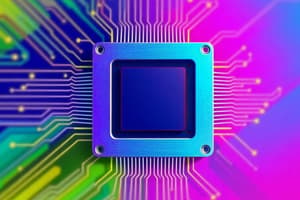Podcast
Questions and Answers
What is the primary function of an encoder in the context of binary logic?
What is the primary function of an encoder in the context of binary logic?
- To convert multiple inputs into fewer ouputs. (correct)
- To decode encrypted data.
- To amplify the input signal.
- To convert fewer inputs into multiple outputs.
In binary arithmetic, which operation is typically performed using 2's complement?
In binary arithmetic, which operation is typically performed using 2's complement?
- Multiplication
- Division
- Subtraction (correct)
- Addition
What is the role of the Arithmetic Logic Unit (ALU) within a CPU?
What is the role of the Arithmetic Logic Unit (ALU) within a CPU?
- Performing arithmetic and logical operations (correct)
- Managing memory addresses
- Holding temporary data
- Directing the execution of instructions
Which of the following is a characteristic of assembly language?
Which of the following is a characteristic of assembly language?
Which of the following represents the correct sequence of steps in CPU instruction execution?
Which of the following represents the correct sequence of steps in CPU instruction execution?
What is the purpose of a full adder in binary arithmetic?
What is the purpose of a full adder in binary arithmetic?
In the context of 2's complement subtraction, what is the first step?
In the context of 2's complement subtraction, what is the first step?
What is the primary difference between a multiplexer (MUX) and a demultiplexer (DEMUX)?
What is the primary difference between a multiplexer (MUX) and a demultiplexer (DEMUX)?
Which of the following registers is typically used to hold the address of the next instruction to be executed?
Which of the following registers is typically used to hold the address of the next instruction to be executed?
In CPU architecture, what is the role of the Control Unit?
In CPU architecture, what is the role of the Control Unit?
What is the primary advantage of using assembly language over machine code?
What is the primary advantage of using assembly language over machine code?
In the ARM assembly instruction MOV R0, #5, what is the operation being performed?
In the ARM assembly instruction MOV R0, #5, what is the operation being performed?
Which component of a basic computer organization is responsible for facilitating communication between the CPU, memory, and I/O devices?
Which component of a basic computer organization is responsible for facilitating communication between the CPU, memory, and I/O devices?
Which of these operations is NOT typically part of binary arithmetic?
Which of these operations is NOT typically part of binary arithmetic?
How does a decoder differ functionally from an encoder?
How does a decoder differ functionally from an encoder?
When performing subtraction using 2's complement arithmetic, what should be done with the carry-out?
When performing subtraction using 2's complement arithmetic, what should be done with the carry-out?
In the MIPS assembly instruction lw $t0, 0($s0), what operation is being performed?
In the MIPS assembly instruction lw $t0, 0($s0), what operation is being performed?
What is the key role of the Memory Address Register (MAR) in basic computer organization?
What is the key role of the Memory Address Register (MAR) in basic computer organization?
Which of the following best describes the relationship between assembly language and machine language?
Which of the following best describes the relationship between assembly language and machine language?
What is the significance of mnemonics in assembly language programming?
What is the significance of mnemonics in assembly language programming?
What is the primary purpose of the Instruction Register (IR) in a CPU?
What is the primary purpose of the Instruction Register (IR) in a CPU?
In complex binary arithmetic operations, what is one reason for using 2's complement representation?
In complex binary arithmetic operations, what is one reason for using 2's complement representation?
How does the function of a demultiplexer (DEMUX) relate to its use in memory addressing?
How does the function of a demultiplexer (DEMUX) relate to its use in memory addressing?
Consider a system using both a multiplexer (MUX) and a demultiplexer (DEMUX) for data transmission. Where would you typically find the MUX placed in relation to the DEMUX?
Consider a system using both a multiplexer (MUX) and a demultiplexer (DEMUX) for data transmission. Where would you typically find the MUX placed in relation to the DEMUX?
Given the ARM assembly instruction ADD R1, R0, #2, what potential issue must be considered when executing this instruction in a pipelined processor?
Given the ARM assembly instruction ADD R1, R0, #2, what potential issue must be considered when executing this instruction in a pipelined processor?
In modern CPU design, how does the separation of the ALU and Control Unit contribute to improved performance?
In modern CPU design, how does the separation of the ALU and Control Unit contribute to improved performance?
What is a primary challenge in implementing subtraction using 2's complement in hardware, considering potential overflow conditions?
What is a primary challenge in implementing subtraction using 2's complement in hardware, considering potential overflow conditions?
Why is the Program Counter (PC) crucial for the correct sequencing of instructions in modern CPUs?
Why is the Program Counter (PC) crucial for the correct sequencing of instructions in modern CPUs?
In an advanced computer architecture, if the Memory Address Register (MAR) fails, what is the most likely immediate consequence?
In an advanced computer architecture, if the Memory Address Register (MAR) fails, what is the most likely immediate consequence?
Which of the following is NOT a typical characteristic of registers within a CPU?
Which of the following is NOT a typical characteristic of registers within a CPU?
What critical role do buses play in enabling scalable and modular computer system designs?
What critical role do buses play in enabling scalable and modular computer system designs?
Considering both ARM and MIPS assembly languages, what is a key architectural difference that influences their assembly instruction sets?
Considering both ARM and MIPS assembly languages, what is a key architectural difference that influences their assembly instruction sets?
How would an error in the 'Decode' stage of a CPU's instruction execution cycle most likely manifest itself?
How would an error in the 'Decode' stage of a CPU's instruction execution cycle most likely manifest itself?
In the context of CPU registers, what is the most significant trade-off when increasing the number of general-purpose registers in a CPU design?
In the context of CPU registers, what is the most significant trade-off when increasing the number of general-purpose registers in a CPU design?
If a CPU's ALU were redesigned to completely eliminate dedicated hardware multiplication and division circuits, how would this change most directly impact software execution?
If a CPU's ALU were redesigned to completely eliminate dedicated hardware multiplication and division circuits, how would this change most directly impact software execution?
Imagine a scenario where a critical fault in the Control Unit causes it to misinterpret instruction opcodes. What is the most catastrophic potential outcome?
Imagine a scenario where a critical fault in the Control Unit causes it to misinterpret instruction opcodes. What is the most catastrophic potential outcome?
Consider a novel computer architecture where the traditional separation between CPU and Memory is blurred, with computational elements embedded directly within the memory modules. What fundamental programming paradigm shift would be necessary to fully exploit this architecture's capabilities?
Consider a novel computer architecture where the traditional separation between CPU and Memory is blurred, with computational elements embedded directly within the memory modules. What fundamental programming paradigm shift would be necessary to fully exploit this architecture's capabilities?
Flashcards
Binary Encoder
Binary Encoder
Converts multiple inputs to fewer outputs (e.g., 8->3).
Binary Decoder
Binary Decoder
Converts fewer inputs to more outputs (e.g., 3->8).
Half Adder
Half Adder
Adds two single bits, outputting the sum and carry.
Full Adder
Full Adder
Signup and view all the flashcards
Binary Arithmetic
Binary Arithmetic
Signup and view all the flashcards
Subtraction with 2's Complement
Subtraction with 2's Complement
Signup and view all the flashcards
Multiplexer (MUX)
Multiplexer (MUX)
Signup and view all the flashcards
Demultiplexer (DEMUX)
Demultiplexer (DEMUX)
Signup and view all the flashcards
Basic Computer Organization
Basic Computer Organization
Signup and view all the flashcards
Important registers
Important registers
Signup and view all the flashcards
Registers
Registers
Signup and view all the flashcards
ALU (Arithmetic Logic Unit)
ALU (Arithmetic Logic Unit)
Signup and view all the flashcards
Control Unit
Control Unit
Signup and view all the flashcards
Assembly Language
Assembly Language
Signup and view all the flashcards
CPU Instruction Execution
CPU Instruction Execution
Signup and view all the flashcards
Study Notes
Binary Encoder & Decoder
- Encoder converts multiple inputs to fewer outputs; for example, it converts 8 inputs to 3 outputs
- Decoder converts fewer inputs to more outputs; for example, it converts 3 inputs to 8 outputs
Binary Adders and Subtractors
- Half Adder adds 2 bits, resulting in a sum and a carry
- Full Adder adds 2 bits and a carry-in
- Subtraction is done via 2's complement
Binary Arithmetic
- Includes performing addition, subtraction, multiplication, and division in binary
Subtraction with 2's Complement
- Invert the bits of the number B (1's complement), then add 1 to get the 2's complement
- Add the result to A and ignore any carry-out
Multiplexer & Demultiplexer
- MUX takes many inputs and produces 1 output using a selector
- DEMUX takes 1 input and produces many outputs
Basic Computer Organization
- Includes the CPU, Memory, I/O, and Buses
- Uses Registers such as MAR, MDR, PC, and IR
CPU Architecture
- Registers are temporary data holders
- ALU performs operations
- Control Unit directs execution
Assembly Language
- Uses mnemonics such as ADD, SUB, and MOV
- Closer to machine language
CPU Instruction Execution
- Instructions are executed in the following order: Fetch, Decode, Execute, Store
ARM vs MIPS Assembly
- ARM Assembly example: MOV R0, #5 | ADD R1, R0, #2
- MIPS Assembly example: add $t0, $t1, $t2 | lw $t0, 0($s0)
Studying That Suits You
Use AI to generate personalized quizzes and flashcards to suit your learning preferences.




